Kuji Hoshinpo (Nine Syllable Protection Technique) is a ritual performed as part of Shugen-do that uses nine syllables—“Rin, Pyō, To, Sha, Kai, Jin, Retsu, Zai, Zen”—along with nine hand seals to pray for the dispelling of calamities and victory in battle. This method is also known as “Kuji-giri.”
Originally, this practice was not a formal method in Buddhism but evolved as a unique Japanese tradition through the incorporation of elements from Taoist secret chants (Rokko Hi-ju) and other influences. In medieval times, samurai used this ritual before heading into battle to protect themselves and secure victory, and ninjas later adopted it as a protective charm. Furthermore, certain practices using specific nine syllables have also been passed down among followers of Nichiren Buddhism.
Additionally, the “Marishiten Method”—a technique said to have been practiced on the battlefield by samurai—used hand gestures that mimicked a sword and its scabbard, embodying prayers to Marishiten, the guardian deity.
In this way, the Kuji Hoshinpo has been handed down through faith and rigorous training since ancient times as a method of aligning the mind and protecting oneself, taking on various forms even today.
Purpose and Effects of Kuji-giri
Kuji-giri has long been practiced in various contexts to support the spirit. Its main intended benefits include:
- Mental Focus:
It is believed to calm the mind and enhance concentration. - Cleansing:
It purifies places, objects, and even the body and mind. - Protection:
It is thought to ward off evil spirits and negative energies, protecting both body and mind. - Avoiding Misfortune:
It is believed to help prevent calamities and misfortunes, ensuring a safe life. - Fortune Enhancement:
It is said to elevate one’s luck, drawing success and happiness. - Guardian Effect:
In addition to preventing negative influences, it can also bring a sense of inner security. - Energy Balancing:
It may help maintain the balance of energy within the body.
Even in modern times, when feeling stressed, anxious, or in need of enhanced concentration, practicing Kuji-giri is believed to promote mental stability and personal growth. However, while these effects are widely reported, they do not have robust scientific backing; they may be understood as a form of self-suggestion or placebo effect. By reciting affirmations such as “I am safe” and “I am strong” during the practice, practitioners might experience a positive shift in their mental and physical states.
Reasons Why Kuji- giri Should Not Be Performed Carelessly
Kuji-giri is an advanced technique traditionally practiced by those who have undergone rigorous training—such as Shugen-do practitioners, onmyoji, and ninjas. Without the proper knowledge and understanding, one may not only fail to achieve the desired effects but might even incur adverse consequences.
If performed incorrectly, the manipulation of one’s spiritual energy might go awry, potentially attracting negative forces or disrupting one’s energy balance. Although scientific evidence is lacking, some believe that an unsettled mind can invite misfortune. Therefore, Kuji-giri requires a sincere commitment, proper guidance, and adherence to established procedures; a casual or unprepared approach may lead to unexpected confusion or distress.
The Method of Performing Kuji-giri
In Japan, the Kuji practice begins by forming the “Dokko-in” (Single Hook Seal) with the hands while vocalizing “Rin.”
Next, practitioners sequentially form the following hand seals—Daikongorin-in (Vajra Wheel Seal), Gaishishi-in (Outer Lion Seal), Naishishi-in (Inner Lion Seal), Gebaku-in (Outer Binding Seal), Naibaku-in (Inner Binding Seal), Chiken-in (Wisdom Fist Seal), Nichirin-in (Sun Wheel Seal), and Hōhei-in (also known as Ongyō Seal)—while reciting the nine syllables “Rin, Pyō, To, Sha, Kai, Jin, Retsu, Zai, Zen.”
Finally, by forming the “Tō-in” (Sword Seal), the practitioner draws a grid of four vertical and five horizontal lines in the air. In Taoism, this method is known as “Jūjū-hō” (Vertical and Horizontal Method), while in Shugen-do it is commonly referred to as “Kuji-giri.”
Hand Seals for Kuji-giri
Rin
Hand Seal: Dokko-in (Single Hook Seal)
Both index fingers are held straight while the other fingers are curled and interlaced.
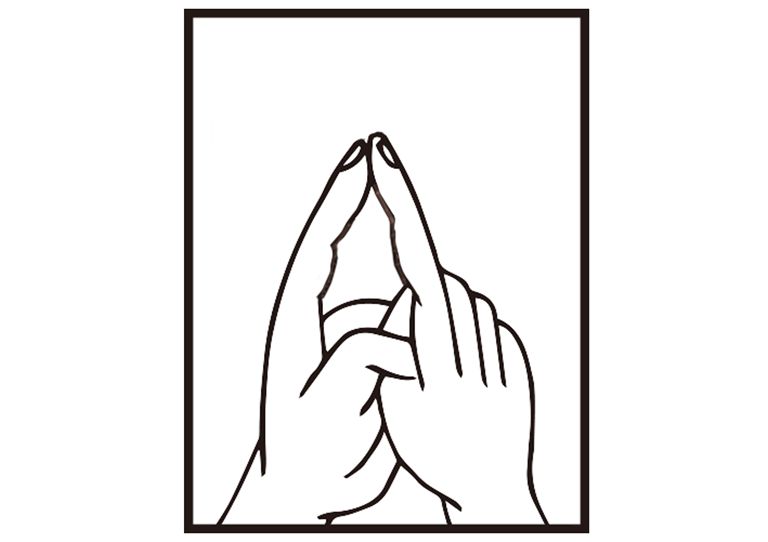
Pyō
Hand Seal: Daikongorin-in (Vajra Wheel Seal)
Both index fingers are held straight with the middle fingers placed over them; the ring and little fingers are curled, and the thumbs are held straight.
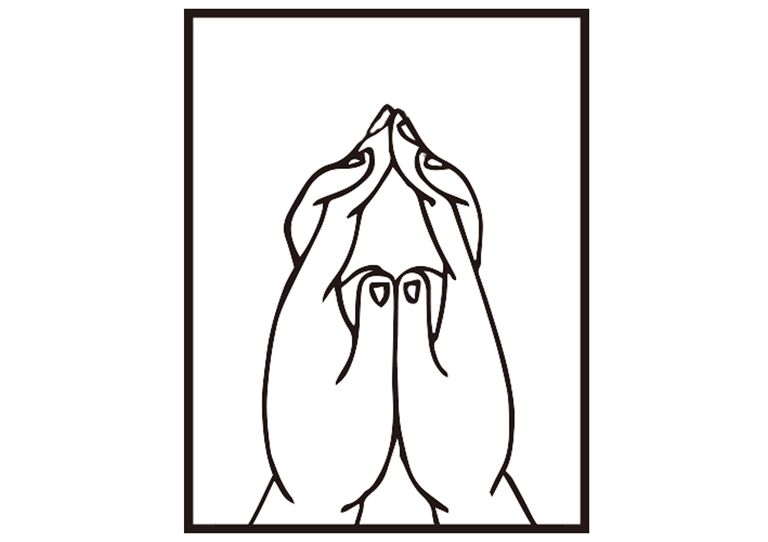
To
Hand Seal: Gaishishi-in (Outer Lion Seal)
- Pass the right index and middle fingers between the left-hand fingers. Specifically, the right fingers pass over the left index finger, under the left middle finger, and above the left ring finger.
- Then, use the right middle finger to grip the left index finger, and the left middle finger to grip the right middle finger.
- Finally, bring the thumbs together while the tips of the ring and little fingers touch.
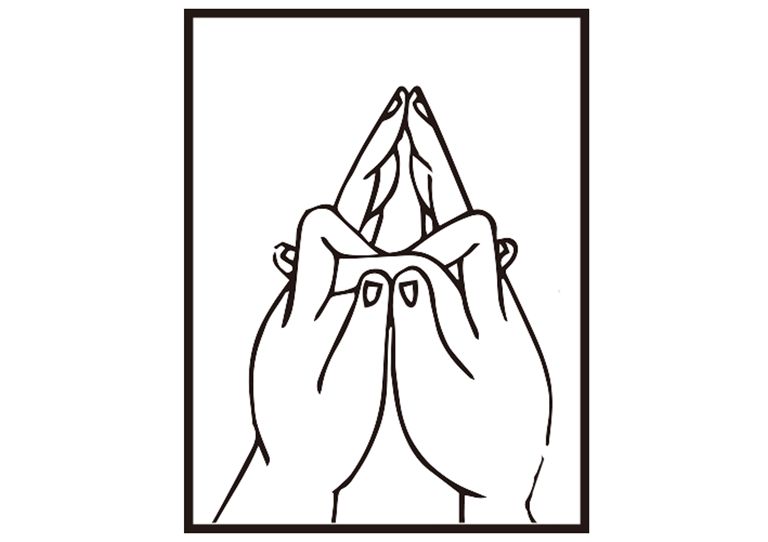
Sha
Hand Seal: Naigishi-in (Inner Lion Seal)
Both the index finger and thumb are held straight while the remaining fingers are interlaced and crossed.
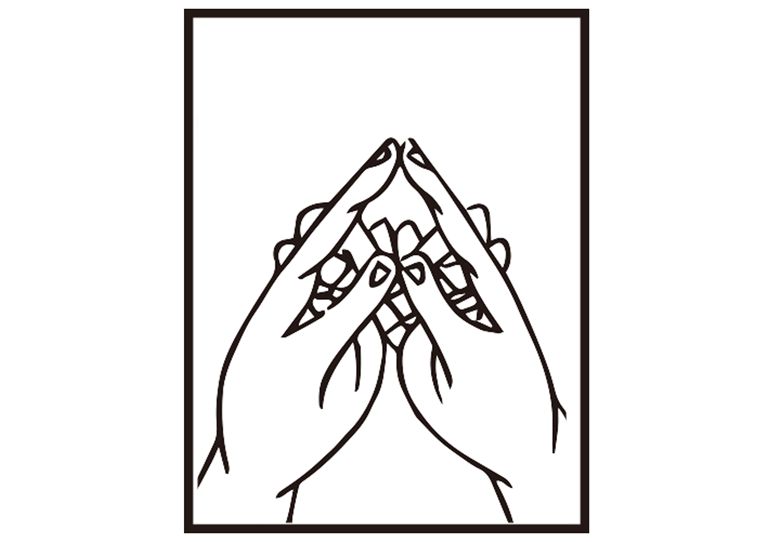
Kai
Hand Seal: Gebaku-in (Outer Binding Seal)
All fingers are curled outward and interlocked.
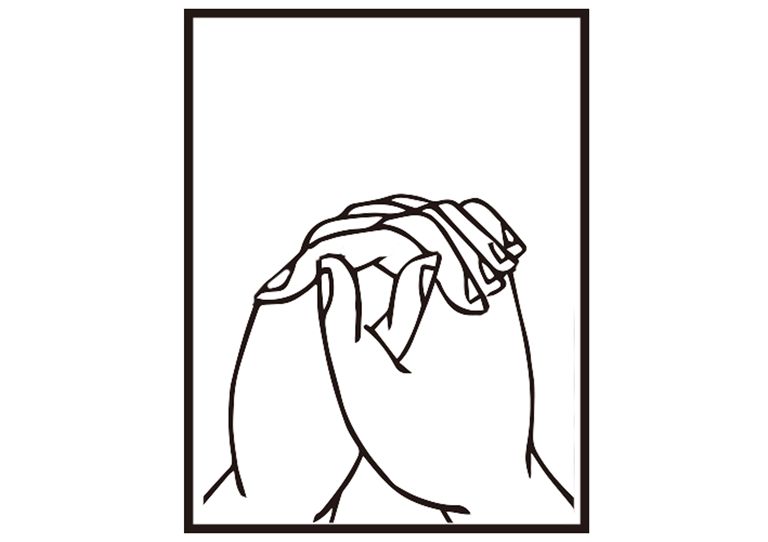
Jin
Hand Seal: Naibaku-in (Inner Binding Seal)
All fingers are curled inward and interlocked.
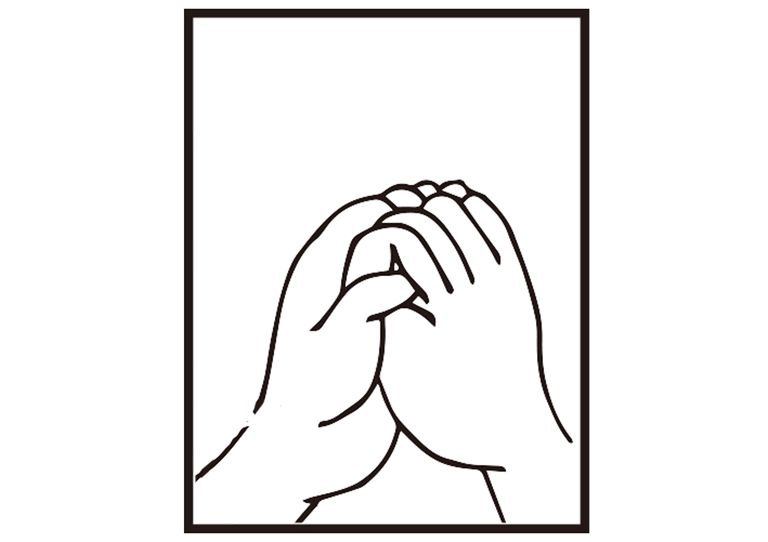
Retsu
Hand Seal: Chiken-in (Wisdom Fist Seal)
Hold the left index finger straight; then, use the right hand to wrap around and grip that finger while tucking the right thumb inward.
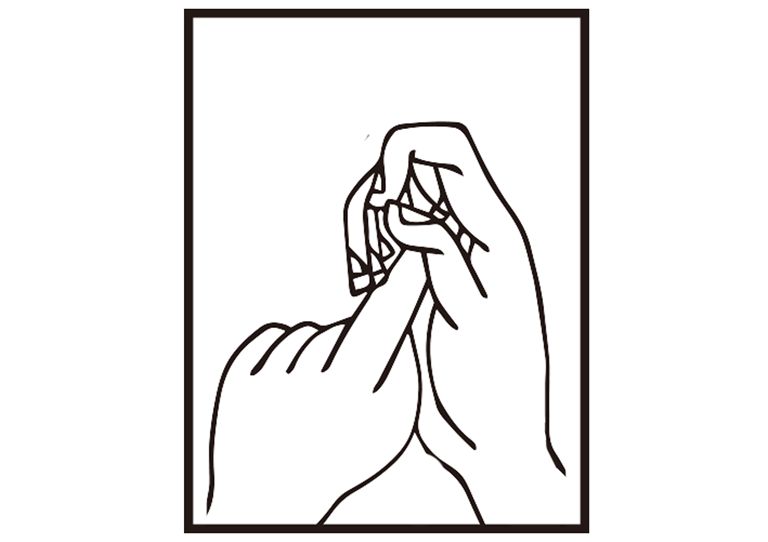
Zai
Hand Seal: Nichirin-in (Sun Wheel Seal)
Both hands form a circle using the thumb and index finger.
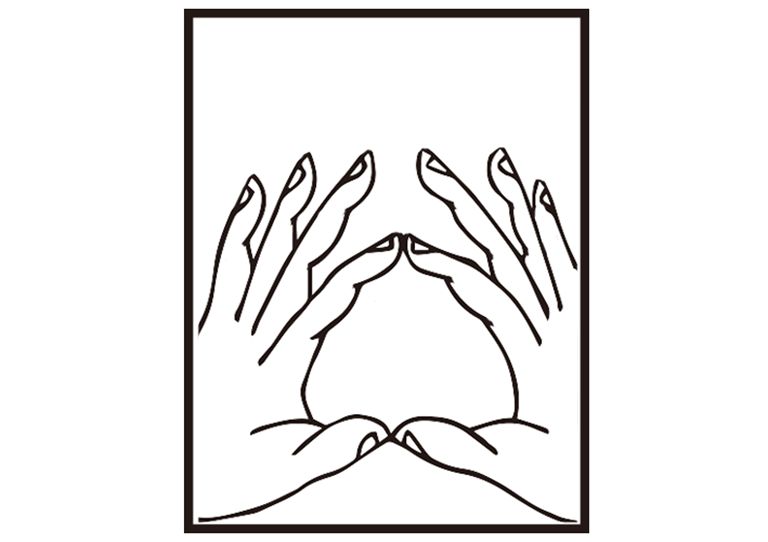
Zen
Hand Seal: Ongyō-in (Hidden Seal)
Form a circle with the left thumb and index finger while gently gripping the remaining left-hand fingers; then, encase the left hand with the right hand.
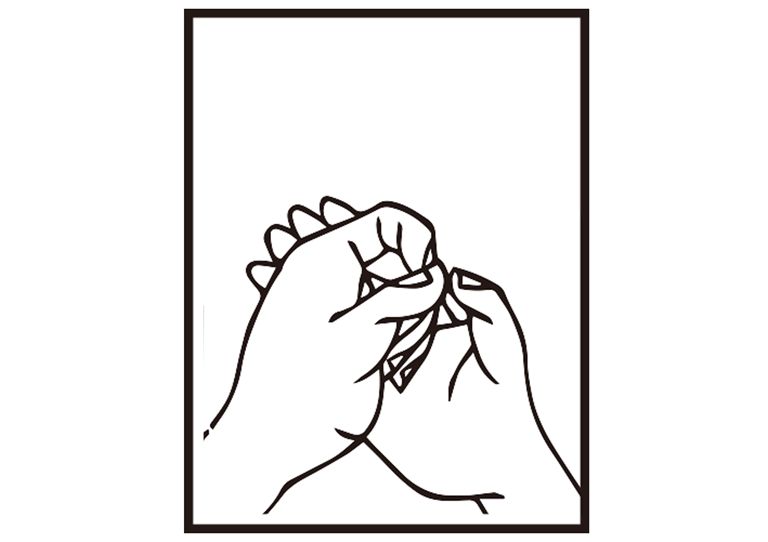
The Sword Seal
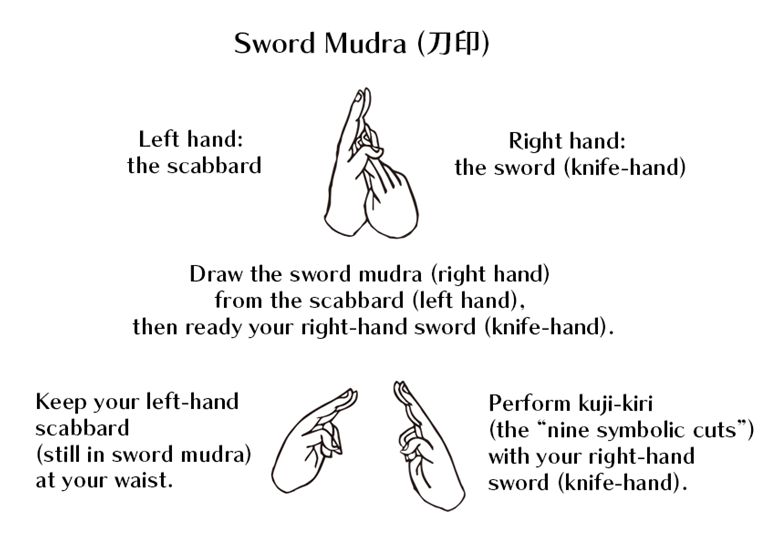
After forming the Sword Seal, the practitioner releases the fingers from the right “hand-sword” while keeping the left hand in the Sword Seal position against the waist.
Using the right “hand-sword,” recite the nine syllables (“Rin, Pyō, To, Sha, Kai, Jin, Retsu, Zai, Zen”) while drawing a grid of four vertical and five horizontal lines in the air. The sequence in which the nine characters are “cut” is shown in the image below.
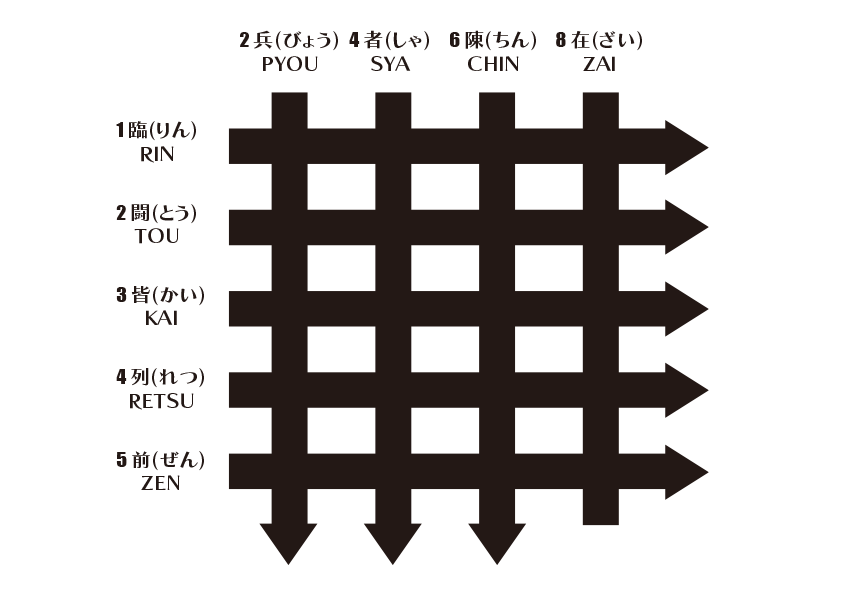
The New Role of Kuji-giri – Its Meaning and Potential
In today’s society, where daily stress and anxiety impact our inner world, traditional techniques are finding new relevance. Although there is no definitive scientific proof, Kuji-giri is increasingly regarded as a method to calm the mind and align one’s inner self. It is believed that practicing Kuji-giri may offer the following benefits:
- Mental Reset:
The focused sequence of movements in Kuji-giri can help clear daily distractions and soothe the mind. - Enhanced Concentration and Creativity:
The rhythmic and intentional motions may boost concentration, potentially sparking fresh ideas and insights. - Deepened Self-Reflection:
By taking time to confront one’s own energy and emotions, practitioners may develop a deeper understanding of themselves, fostering personal growth. - Experience of Inner Harmony:
The ritualistic movements can help balance the body and mind, contributing to a sense of stability and peace.
Thus, beyond being merely an ancient ritual, Kuji-giri has emerged as a practical method for cultivating inner balance and enriching one’s life. Although its effects depend on individual experience and belief, many people see it as a valuable way to mitigate the negative impact of a disturbed mind.
Conclusion
Kuji-giri is a traditional practice that uses the nine syllables “Rin, Pyō, To, Sha, Kai, Jin, Retsu, Zai, Zen” along with the formation of various hand seals and the Sword Seal to dispel worldly attachments, obstacles, and negative entities, while warding off misfortune. Additionally, it serves as a ritual for mental focus—helping practitioners discern between what is beneficial and harmful, thereby potentially keeping negative influences at bay.
Even in modern times, techniques such as meditation and mental focus are noted for their potential to reduce stress and enhance clear judgment. While these benefits are not scientifically proven and largely depend on personal experience, they underscore the enduring appeal of Kuji-giri as a tool for achieving inner peace and balance.
References: Wikipedia · Mizukami Shrine
- Method of Performing and Recording Kuji-giri
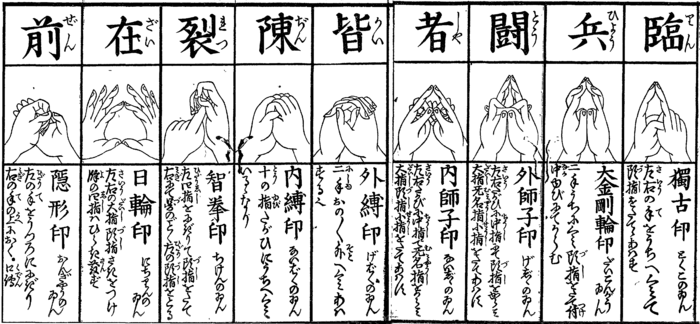
Image Credit: Wikipedia
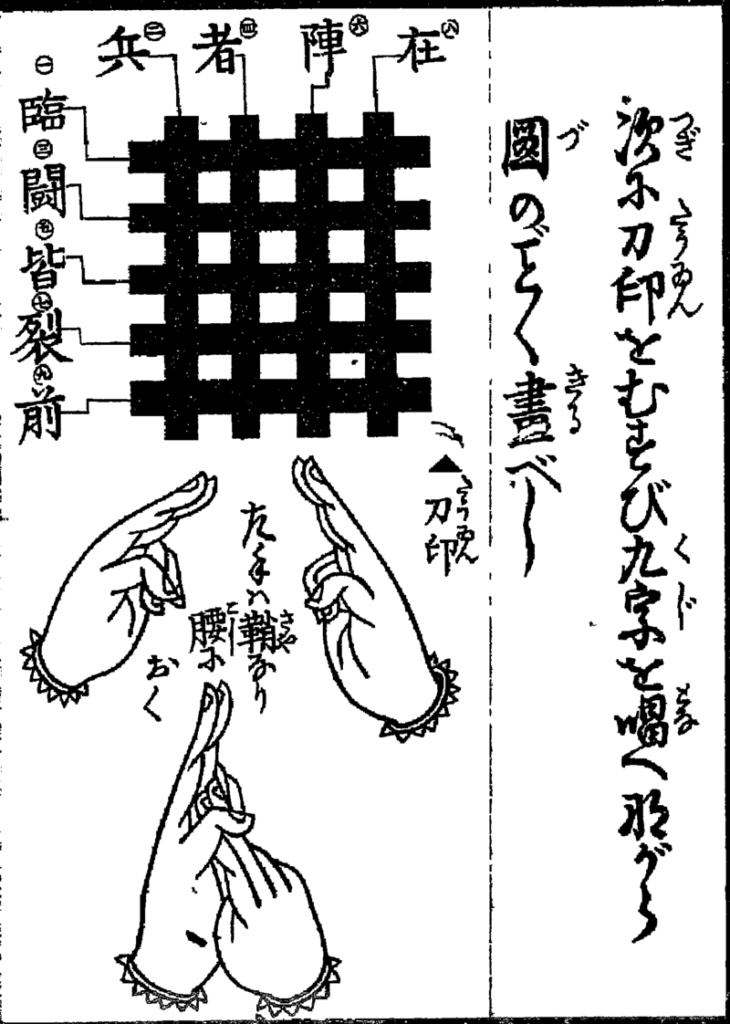
Image Credit: Wikipedia

Comments